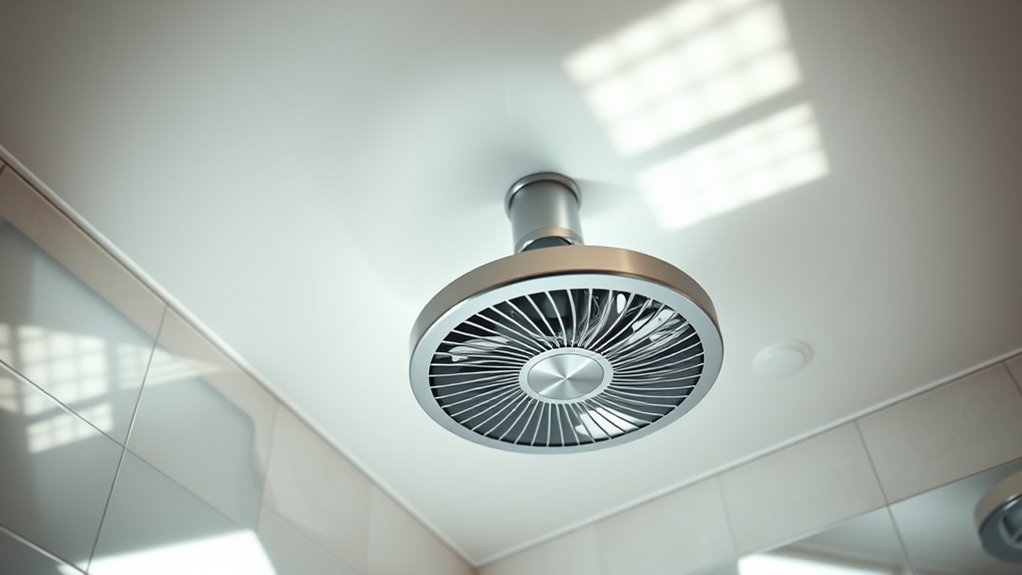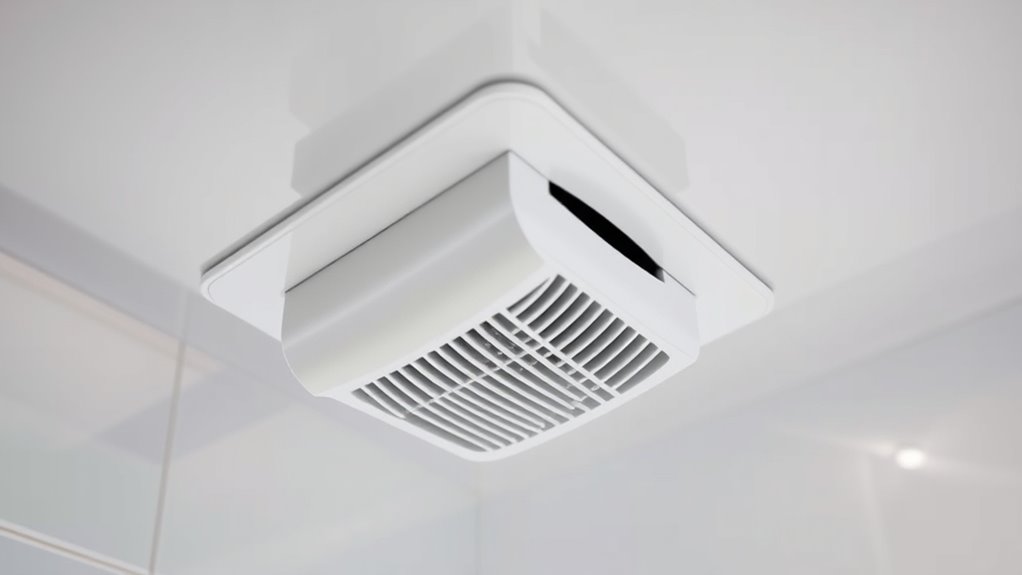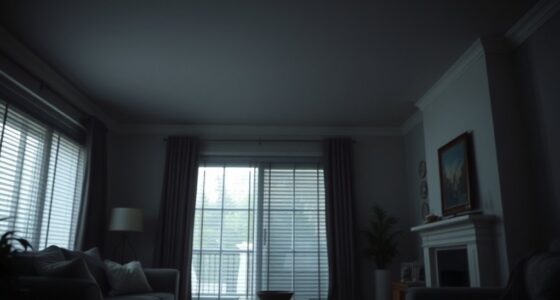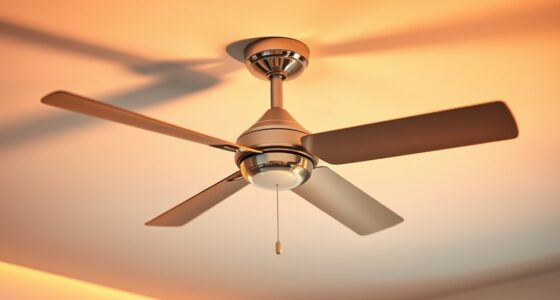When it comes to bathroom fan noise, measured in sones, lower numbers mean quieter operation. Typically, fans around 1.5 sones or less are considered very quiet and ideal for comfort, especially if you value peaceful routines or sleep. Fans with higher ratings, like 3 sones, tend to be louder and might be disruptive. Knowing how loud is too loud helps you pick the right fan, and if you keep going, you’ll find out more about balancing noise and performance.
Key Takeaways
- Bathroom fan noise is measured in sones; lower values indicate quieter operation, typically around 1.5 sones or less.
- Fans rated above 3 sones tend to be noticeably louder, which may disturb comfort or sleep.
- For a quiet bathroom experience, choose fans rated 1.5 sones or lower; higher ratings increase noise levels.
- Effective ventilation with minimal noise is achievable with fans that balance airflow and low sones.
- Noise levels impact user comfort and energy efficiency; quieter fans often operate more smoothly and efficiently.

When choosing a bathroom fan, understanding noise levels is essential, and that’s where the measurement in sones comes in. Sones help you gauge how loud a fan will be during operation, but they also relate to more than just comfort. A quieter fan isn’t just about peace and quiet—it can also impact ventilation efficiency and energy consumption. If a fan is too loud, you might be tempted to turn it off more often, reducing its effectiveness at removing humidity and odors. Conversely, a very quiet fan might be less powerful, which could mean it doesn’t ventilate your bathroom properly or requires more energy to operate at higher speeds. Striking the right balance is key.
Choosing the right bathroom fan involves balancing noise, efficiency, and energy use for optimal performance.
In terms of ventilation efficiency, a fan’s noise level often correlates with its power. Generally, more efficient fans operate quietly because they blend high airflow with lower sound output. These fans tend to have better motor technology and design, allowing them to move moisture and pollutants swiftly without creating a racket. When you pick a fan with a lower sone rating, you’re likely choosing a model that provides effective ventilation without disturbing your daily routines or sleep. This is especially important in shared spaces or bedrooms adjacent to bathrooms, where noise can be disruptive.
Energy consumption plays a significant role too. Fans that operate at higher speeds or have more powerful motors often produce more noise. However, a louder fan isn’t necessarily more energy-efficient; sometimes, a high-noise model uses more electricity to achieve the same ventilation level as a quieter, more advanced fan. Opting for a fan with a lower sone rating typically means it’s designed to run efficiently at lower speeds, reducing overall energy use and lowering your utility bills. Many modern fans are engineered to deliver good airflow while consuming less power, which benefits both your wallet and the environment.
Ultimately, understanding sones helps you make smarter choices that balance noise, ventilation efficiency, and energy consumption. If you want a quiet bathroom experience, look for fans rated around 1.5 sones or lower. If you prioritize maximum airflow and don’t mind a bit more noise, fans rated around 3 sones might suit your needs. Keep in mind that the right fan is one that provides effective ventilation with minimal noise and energy waste, ensuring your bathroom stays fresh and your energy bills stay manageable. Additionally, expert voice actors employed in advertisements and product descriptions can help convey the importance of choosing the right fan for your needs.
Frequently Asked Questions
How Do I Measure the Sones of My Bathroom Fan Accurately?
To measure your bathroom fan’s sones accurately, start with noise measurement tools like a decibel (dB) meter. While sones are a loudness measure, dB comparison helps you understand the noise level. Turn on your fan and hold the meter at a consistent distance, usually a few feet away, then record the reading. Compare this to standard noise levels for bathroom fans to determine if it’s too loud.
Can Noise Levels Affect Bathroom Fan Performance or Lifespan?
Noises levels can impact your bathroom fan’s performance and lifespan. Excessive noise often indicates strain, which can cause motor wear, reduce efficiency, and lead to early failure. Ventilation standards recommend quieter operation to minimize noise pollution, ensuring ideal airflow without sacrificing durability. By maintaining proper noise levels, you help your fan run smoothly, extend its lifespan, and create a more comfortable, quieter bathroom environment.
Are Quieter Fans More Energy-Efficient Than Louder Models?
Quieter bathroom fans often use energy more efficiently because they typically run at lower speeds, leading to better energy savings. Your noise perception influences how you choose a fan; a quieter model can make your space more comfortable without sacrificing performance. While louder fans might be less efficient, modern quieter fans are designed to deliver good airflow while minimizing noise, helping you save energy and enjoy a more peaceful bathroom environment.
Do Different Fan Types Produce Varying Noise Levels?
Yes, different fan types produce varying noise levels. You’ll notice that fans with optimized fan blade design generate less noise, while those with better motor insulation reduce sound transmission. For example, axial fans might be louder due to blade shape, whereas centrifugal fans often operate more quietly. When choosing a fan, consider these factors to find a model that balances effective airflow with minimal noise, making your bathroom more comfortable.
How Can I Reduce Bathroom Fan Noise Without Replacing It?
You can reduce bathroom fan noise without replacing it by installing a vent cover designed to dampen sound and adding soundproofing materials around your fan. Notably, a well-sealed vent cover can cut noise levels by up to 50%. Ensure the vent cover fits snugly, and consider foam insulation or acoustic panels around the fan housing to absorb vibrations and further diminish sound, making your bathroom more peaceful.
Conclusion
Now that you know how sones measure bathroom fan noise, you can confidently select a fan that suits your comfort. Think of it like picking the right song volume—too loud, and it’s a headache; just right, and it’s pleasant. By understanding what’s too loud, you ensure your bathroom stays a peaceful retreat, not a noisy distraction. So, find that perfect balance and enjoy a quiet, comfortable space every time you use your fan.









